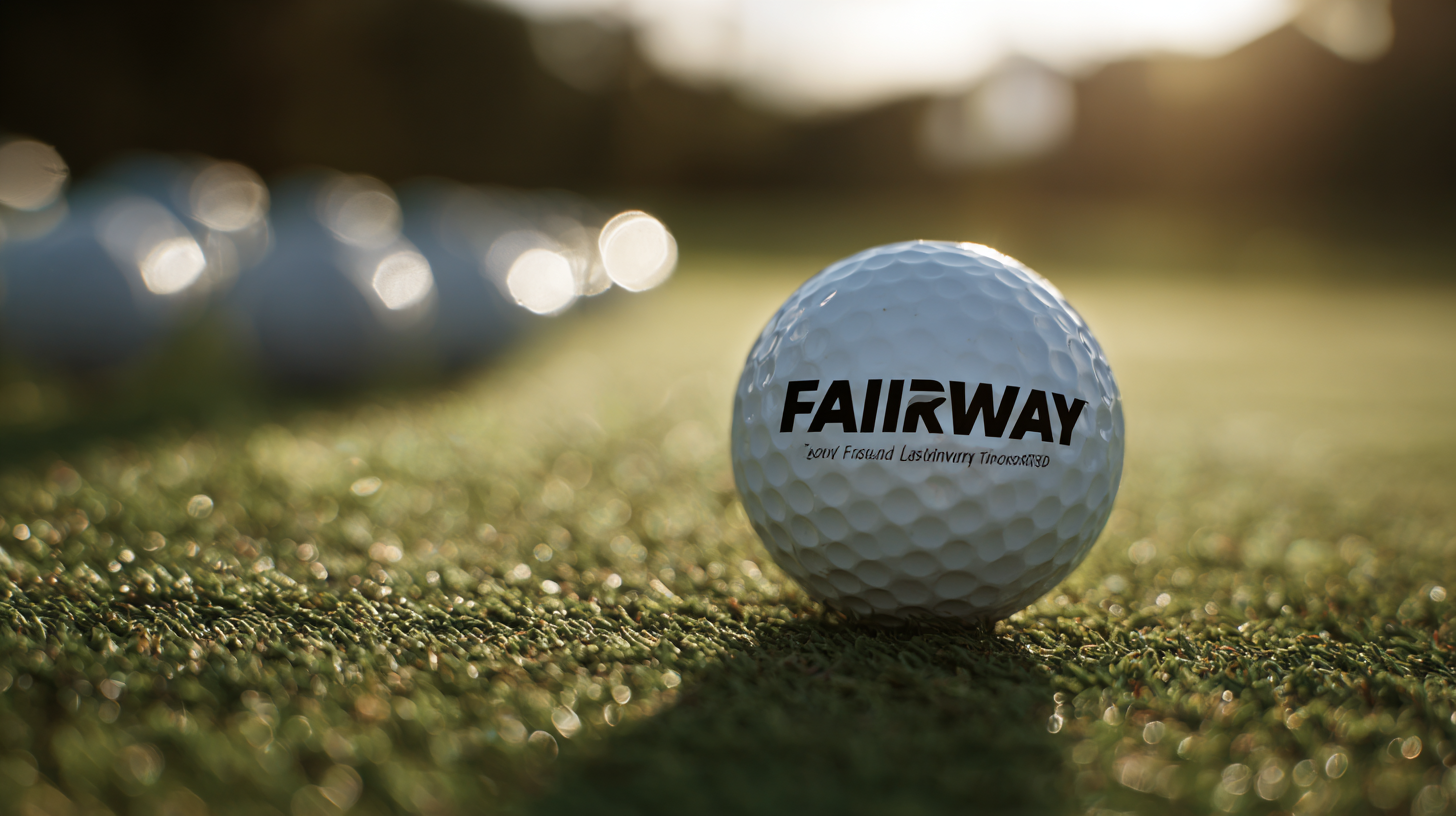

In recent years, the global golf industry has witnessed significant growth, with the golf fairway market emerging as a focal point. According to a report by Grand View Research, the golf course construction market alone is projected to reach USD 12.83 billion by 2025, underscoring the increasing demand for high-quality golf fairways. As international buyers seek premium products, China has positioned itself as a leader in golf fairway production, boasting advanced manufacturing capabilities and a reputation for excellence. With a production output catering to a diverse range of needs, including environmentally sustainable grass species and cutting-edge agronomic practices, Chinese manufacturers are not only meeting but exceeding global standards.

This blog explores how China's robust export strength and expertise are setting benchmarks in the golf fairway industry, making it the go-to source for golf course developers around the world.
The premium golf fairway market has witnessed significant growth, driven by a rising global interest in golf as a leisure activity. According to a report by the Sports and Fitness Industry Association, golf participation has increased by 20% in the last decade, with more than 24 million players in the United States alone. This surge in interest has prompted a demand for high-quality fairways that enhance the playing experience, encouraging manufacturers to innovate and expand their offerings to cater to diverse markets.
Industry applications of premium golf fairways extend beyond traditional golf courses. For example, municipalities and resorts are increasingly investing in artificial turf and hybrid systems that provide all-season playability with reduced maintenance costs. A recent study by the National Golf Foundation shows that nearly 50% of new golf facilities are opting for these sustainable solutions, as they align with both environmental goals and economic efficiency. Additionally, the hospitality sector has recognized the potential of integrated golf experiences, leading to the development of luxury resorts featuring state-of-the-art fairways that attract both avid golfers and casual visitors, further fueling market expansion and diversification.
The golf industry has seen a transformative shift thanks to innovative techniques in fairway production. According to the National Golf Foundation, as of 2021, the U.S. golf market generated approximately $84 billion, with turf management accounting for a significant portion of that revenue. The application of advanced aeration, soil management, and grass hybrids have revolutionized the way courses are maintained and developed, creating more resilient and playable surfaces that can withstand varying climatic conditions.
One standout technique is the use of precision agriculture, where technology such as drones and GPS mapping is employed to monitor and manage fairway health. A report from the Golf Course Superintendents Association of America (GCSAA) noted that the introduction of smart irrigation systems has reduced water usage by up to 30% in some regions, enhancing sustainability without sacrificing quality. Additionally, the integration of organic fertilizers and environmentally friendly pest control methods have further improved the quality of fairway turf while supporting ecological balance, meeting the growing demand from environmentally conscious international buyers. As the global market for golf continues to expand, these innovative practices will play a crucial role in meeting the diverse needs of players and courses worldwide.
| Production Technique | Description | Sustainability Impact | Cost Efficiency |
|---|---|---|---|
| Aeration | Process of perforating soil with holes to allow air, water, and nutrients to penetrate deep into the roots. | Improves soil health and reduces the need for chemical fertilizers. | Reduces costs by minimizing the requirement for synthetic treatments. |
| Seed Selection | Choosing drought-resistant and disease-resistant grass types for fairway growth. | Enhances ecosystem resilience and promotes biodiversity. | Lowers maintenance costs due to reduced disease management. |
| Precision Irrigation | Utilizing technology to deliver the right amount of water at the right time. | Conserves water resources and lowers runoff pollution. | Saves on water bills and reduces labor costs associated with traditional methods. |
| Soil Amendment | Adding organic and natural materials to enhance soil fertility. | Supports healthier plant growth and reduces dependency on chemical inputs. | Cost-effective in the long run by improving soil quality sustainably. |
| Integrated Pest Management (IPM) | Combining biological, cultural, physical, and chemical tools to manage pests. | Reduces chemical pesticide use, promoting a healthier environment. | Provides economic savings through reduced pesticide expenses. |
When it comes to selecting the right golf fairway materials, understanding the various options available is crucial for international buyers. The choice often boils down to natural grass, synthetic turf, and hybrid systems, each with distinct characteristics.
 Natural grass provides an authentic playing experience and is favored for its aesthetic appeal, but it demands more maintenance. On the other hand, synthetic turf offers durability and low upkeep costs, making it an attractive alternative for locations with challenging climates or limited resources. Hybrid systems combine the best of both worlds, incorporating natural grass with synthetic fibers to enhance resilience and playability.
Natural grass provides an authentic playing experience and is favored for its aesthetic appeal, but it demands more maintenance. On the other hand, synthetic turf offers durability and low upkeep costs, making it an attractive alternative for locations with challenging climates or limited resources. Hybrid systems combine the best of both worlds, incorporating natural grass with synthetic fibers to enhance resilience and playability.
Tips: When choosing the ideal fairway material, consider the local climate and soil conditions. Areas with extreme weather may benefit from synthetic options that withstand wear and tear. Additionally, assess the expected play frequency, as high-traffic areas might require more durable solutions. Lastly, cost analysis is key; while natural grass may have lower initial costs, the long-term maintenance expenses can accumulate, making synthetic options more financially viable in the long run.
The global golf industry continues to evolve, and one crucial element of its success is the quality of golf fairways. Various international case studies demonstrate how innovative fairway solutions have transformed golfing experiences around the world.
In the United States, a renowned golf course adopted advanced hybrid turf technology, enabling its fairways to maintain optimal conditions even during the dry season. This resulted in increased playability and player satisfaction, ultimately elevating the course's reputation and visitor revenue.
On the other side of the globe, a prestigious golf resort in Japan implemented a state-of-the-art drainage system to combat heavy rainfall challenges. By utilizing advanced fairway management techniques, the resort ensured that its course remained accessible year-round, attracting both local and international players.
These strategic implementations showcase how a tailored approach to fairway solutions can address unique environmental challenges, boost operational efficiency, and enhance the overall experience for golfers across diverse landscapes.
The golf industry has seen significant growth in recent years, particularly in the realm of international trade. According to a recent report from the International Golf Federation, global golf consumption has surged by over 10% in the past five years, highlighting a robust demand for quality golf products, including fairways. For buyers engaged in sourcing golf fairways, understanding best practices becomes crucial in navigating this competitive landscape. Effective international partnerships and careful selection of suppliers not only help in reducing costs but also ensure the delivery of premium products that meet diverse market needs.

Establishing strong relationships with manufacturers is essential for success in the global fairway market. Recent data suggests that approximately 60% of golf course operators prioritize quality and durability in their fairway investments, emphasizing the importance of sourcing from reputable producers. Furthermore, as environmental considerations take center stage, buyers are increasingly looking for sustainable options that align with their corporate social responsibility goals. By keeping abreast of industry trends and aligning purchasing strategies with these insights, international buyers can effectively optimize their operations and enhance their market presence.